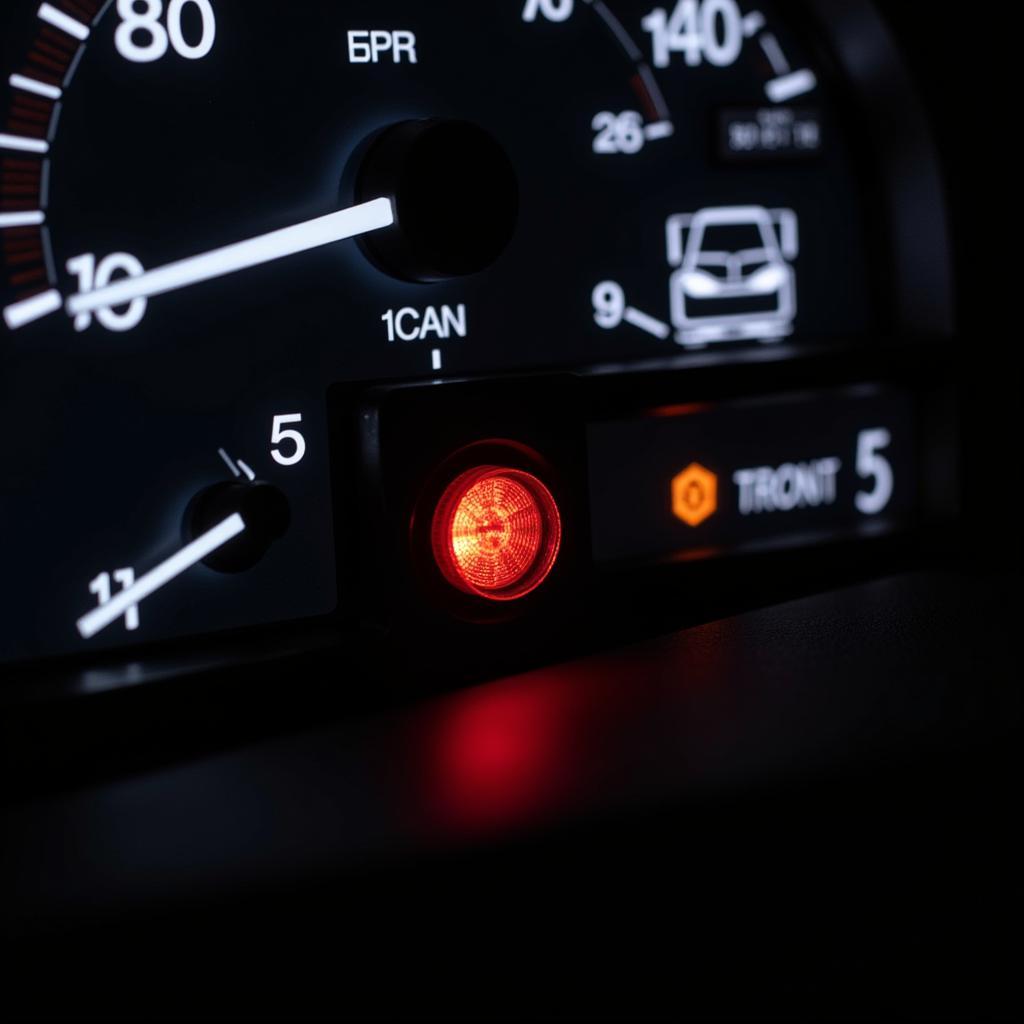The brake pad warning light on your Hino truck is a crucial safety feature that should never be ignored. This light illuminates on your dashboard to alert you that your brake pads have worn down to a point where they require immediate attention. Ignoring this warning can lead to significantly reduced braking performance, potentially resulting in costly repairs and dangerous driving situations. This comprehensive guide delves into the common causes of the Hino brake pad warning light, potential solutions, and essential preventive measures to ensure your truck’s braking system remains in optimal condition.
Deciphering the Hino Brake Pad Warning Light
The brake pad warning light system in Hino trucks is designed with simplicity and effectiveness in mind. It operates based on a sensor embedded within the brake pad itself. This sensor, often a thin wire or a small metal tab, acts as a trigger. As your brake pads wear down through normal use, the sensor gradually gets closer to the brake rotor. Once the brake pad reaches a critically low thickness, the sensor makes contact with the rotor. This contact completes an electrical circuit, instantly illuminating the brake pad warning light on your dashboard.
Common Causes of a Hino Brake Pad Warning Light
While worn brake pads are the most common culprit behind the illuminated warning light, several other factors can contribute to this issue.
1. Worn Brake Pads
This is the most straightforward and frequent cause. Brake pads have a finite lifespan, and as you use your Hino truck, they naturally wear down. Once they reach a certain thinness, the built-in sensor activates the warning light, signaling the need for replacement.
2. Damaged Brake Pad Sensor
Although less common, the brake pad sensor itself can be prone to damage. Exposure to road debris, corrosion, or even improper installation can cause a malfunction, triggering the warning light prematurely.
 Damaged brake pad sensor on Hino truck
Damaged brake pad sensor on Hino truck
3. Low Brake Fluid Level
Brake fluid is the lifeblood of your Hino truck’s braking system. It transmits the force from your foot on the brake pedal to the wheels, enabling the vehicle to slow down or stop. If the brake fluid level drops significantly, it can trigger the brake pad warning light, often accompanied by a spongy or soft brake pedal feel. This indicates a potential leak in the braking system, requiring immediate professional attention.
4. Faulty Brake Light Switch
In some instances, a faulty brake light switch can interfere with the brake pad warning light system. The brake light switch activates your brake lights when you press the pedal, and a malfunction can lead to unusual behavior, including an illuminated warning light.
Troubleshooting and Solutions
If your Hino truck’s brake pad warning light illuminates, taking prompt action is crucial. While worn brake pads are the most likely cause, it’s essential to rule out other possibilities.
Here’s a step-by-step guide to troubleshoot the issue:
-
Check Brake Fluid Level: Park your truck on a level surface, open the hood, and locate the brake fluid reservoir. The reservoir is typically translucent, allowing you to visually inspect the fluid level. If the level is below the minimum mark, add the recommended brake fluid type as specified in your Hino truck’s owner’s manual.
-
Inspect Brake Pads: If the brake fluid level is adequate, the next step is to examine the brake pads themselves. You can often visually inspect the brake pads through the spaces between the wheel spokes. If you’re comfortable with basic mechanical tasks, you can remove a wheel to gain a clearer view. Look for excessively thin brake pads or uneven wear patterns.
Expert Insight: “Uneven brake pad wear can indicate a more serious underlying issue with your Hino truck’s braking system, such as a sticking caliper or a malfunctioning caliper slide pin. Addressing these problems promptly can prevent further damage and ensure optimal braking performance.” – Johnathan Miller, Senior Automotive Technician at Miller’s Auto Repair
-
Consult a Qualified Technician: If you’re unsure about any aspect of inspecting or replacing brake components, it’s always best to consult a qualified technician specializing in Hino trucks. They have the expertise, tools, and experience to diagnose the issue accurately and perform the necessary repairs safely and efficiently.
Preventive Measures: Extending the Lifespan of Your Brake Pads
Proactive maintenance is key to maximizing the lifespan of your Hino truck’s brake pads and ensuring optimal braking performance.
Consider these preventive measures:
- Avoid Aggressive Driving: Harsh braking habits, such as sudden stops and rapid acceleration, can accelerate brake pad wear. Adopting a smoother driving style can significantly extend their lifespan.
- Regular Inspections: Incorporate routine brake inspections into your truck’s maintenance schedule. This allows you to identify potential issues early on and address them before they escalate into major problems.
- Quality Brake Pads: When it’s time to replace your brake pads, opt for high-quality brake pads specifically designed for Hino trucks. These pads are engineered to withstand the demands of heavy-duty use, providing reliable braking performance and longevity.
Conclusion
The brake pad warning light on your Hino truck is a crucial safety feature designed to alert you of potential braking system issues. Understanding its causes and taking prompt action can prevent costly repairs, extend the lifespan of your brake components, and, most importantly, ensure your safety and the safety of others on the road. By following the troubleshooting tips and preventive measures outlined in this guide, you can confidently address brake pad warning light issues and keep your Hino truck operating at peak performance.

